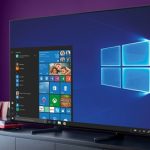Yes, a monitor can be used as a TV with the right connections and compatible devices. Monitors and TVs share similar functionalities, making it possible to adapt a monitor for TV viewing.
Monitors offer high-resolution displays, making them a popular choice for those seeking a versatile screen for multiple uses. With the addition of external speakers or a TV tuner, a monitor can easily serve as a TV for entertainment purposes. By utilizing the appropriate ports and settings, a monitor can provide a seamless TV-like experience without the need for a traditional television set.
Can A Monitor Be Used As A Tv?
A monitor can serve dual purposes, acting as both a computer display and a television screen. Let’s explore the versatility and compatibility of using a monitor as a TV.
Versatility Of Monitors
Monitors are adaptable due to their compact size and sharp display resolution, making them ideal for diverse uses.
Compatibility With Tv Devices
Monitors can connect seamlessly to TV devices like set-top boxes, gaming consoles, and streaming devices, offering a wide range of entertainment options.

Credit: www.pcworld.com
Understanding Different Connections
Hdmi And Displayport
An HDMI port is commonly found on both monitors and TVs, allowing for high-quality audio and video transmission.
DisplayPort is another modern connection option that offers high resolution and refresh rates for a superior viewing experience.
Vga And Dvi
VGA, while becoming less common, was once a popular choice for connecting devices but has limitations in terms of resolution.
DVI provides a digital signal and can support higher resolutions than VGA, offering a clearer picture.
Audio Considerations
When using a monitor as a TV, considering the audio aspect is essential for an immersive entertainment experience. Whether you plan to utilize the built-in speakers or opt for external audio options, understanding the audio considerations is crucial.
Built-in Speakers
When utilizing a monitor as a TV, the built-in speakers can serve as a convenient audio solution. However, it’s important to bear in mind that the audio quality of built-in speakers may not always be as robust as dedicated TV speakers. Nevertheless, for casual viewing, they can suffice and provide a decent audio experience.
External Audio Options
If you desire a more impactful audio experience, incorporating external audio options is a viable choice. Connecting external speakers or a soundbar to the monitor can significantly enhance the audio quality, providing a more fulfilling and dynamic sound. Additionally, utilizing an AV receiver and a speaker system delivers a theater-like audio experience, elevating your viewing sessions to new heights.

Credit: www.avaccess.com
Resolution And Viewing Experience
A monitor with a high resolution can be used as a TV, providing a fantastic viewing experience for watching content. With crisp visuals and vivid colors, it can enhance the overall entertainment experience, making it a versatile option for both work and leisure.
Introduction
When it comes to using a monitor as a TV, one important aspect to consider is the resolution and viewing experience. The resolution determines the clarity and sharpness of the image, and the viewing experience ensures a comfortable and immersive session. In this blog post, we will explore the different resolutions available for monitors used as TVs and how you can adjust them for optimal viewing.
Hd And 4k Resolutions
High Definition (HD) and 4K resolutions are commonly found in both TVs and monitors, and they significantly impact the visual experience.
- HD resolution, also known as 1080p, provides a great level of detail with a resolution of 1920×1080 pixels.
- On the other hand, 4K resolution, also known as Ultra HD, takes it a step further with a resolution of 3840×2160 pixels, offering stunning clarity and sharpness.
Both HD and 4K resolutions ensure that you can enjoy movies, TV shows, and games with incredible precision and lifelike visuals.
Adjusting For Comfortable Viewing
When using a monitor as a TV, it’s essential to adjust the settings for a comfortable viewing experience.
- Firstly, consider the brightness level. Adjust it to a level that prevents eye strain while maintaining a vibrant picture.
- Next, take care of the contrast settings. A balanced contrast ensures that the details are not washed out or over-saturated.
- You can also fine-tune the color settings to your preference. This allows you to enhance the colors or make them more natural, depending on your liking.
- It’s important to find the optimal viewing distance, depending on the monitor size and resolution. Sitting too close may result in visual discomfort or pixelation.
- Lastly, consider the audio setup. Monitors typically have built-in speakers, but for a better audio experience, connecting external speakers or a soundbar can greatly enhance your viewing pleasure.
By adjusting these settings and ensuring a comfortable viewing distance, you can maximize your enjoyment while using a monitor as a TV.
Additional Features And Considerations
Considering additional features and considerations, a monitor can indeed be used as a TV. It’s essential to verify compatibility, audio options, and connectivity to ensure a seamless viewing experience. Some monitors may require external tuners for full TV functionality. Choose wisely based on your specific needs.
Response Time And Refresh Rates
When considering whether a monitor can be used as a TV, it’s important to take into account the additional features and considerations that come with it. Two key factors to consider are the response time and refresh rates. The response time of a monitor determines how quickly it can change from one color to another. A slower response time can result in motion blur, which is especially noticeable during fast-paced action scenes or gaming. On the other hand, a faster response time ensures smoother transitions and a more enjoyable viewing experience. When using a monitor as a TV, opting for a lower response time is crucial. Refresh rates, measured in Hertz (Hz), refer to the number of times an image is refreshed on the screen per second. Higher refresh rates translate to smoother motion and reduced blur. In the case of traditional TVs, the standard refresh rate is usually 60Hz. However, monitors often offer refresh rates of 120Hz or even higher, making them suitable for a more immersive viewing experience, especially for gamers or sports enthusiasts.Mounting And Stand Options
Another crucial consideration when using a monitor as a TV is the mounting and stand options available. Unlike TVs that typically come with a stand included, monitors often require an additional purchase for their stands. Some monitors do come with a stand, but it’s essential to check the specifications before making a choice. Moreover, monitors are designed with VESA mount compatibility, which means they can be easily mounted on walls or monitor arms using VESA-compatible brackets. This flexibility allows for more customization in terms of positioning the monitor according to your preferences and available space. It’s worth noting that not all monitors have VESA mount compatibility, so ensure proper research in this regard. In addition to the mounting options, the adjustability of the stand is crucial for comfortable viewing. Many monitors offer tilt adjustment to find the perfect viewing angle, while some also provide height adjustment and even pivot functionality, allowing for both horizontal and vertical orientation changes. These features can significantly enhance your overall TV-watching experience. In conclusion, considering the response time and refresh rates is vital when using a monitor as a TV, as they directly affect the quality and smoothness of the viewing experience. Furthermore, evaluating the mounting and stand options ensures that the monitor can be easily positioned for the optimal viewing experience. By taking these additional features and considerations into account, you can transform your monitor into a functional and enjoyable TV.
Credit: www.avaccess.com
Frequently Asked Questions Of Can A Monitor Be Used As A Tv
Can You Turn A Computer Monitor Into A Tv?
Yes, you can turn a computer monitor into a TV by using a TV tuner or connecting a set-top box.
Can I Use A Monitor Instead Of A Tv?
Yes, you can use a monitor instead of a TV for watching content with the right connections. Many monitors have HDMI ports and can function as a TV screen. However, monitors might not have built-in speakers and tuner, requiring separate connections for audio and channels.
What Is The Difference Between A Monitor And A Tv?
A monitor is generally used for computer or gaming purposes, while a TV is primarily used for entertainment. Monitors have higher refresh rates and resolutions for better image quality, while TVs are designed for larger screens and include built-in speakers and TV tuners.
Can I Watch Netflix On A Monitor?
Yes, you can watch Netflix on a monitor.
Conclusion
To sum up, a monitor can indeed be used as a TV with the right connections and devices. As technology continues to advance, the line between monitors and TVs is blurring. Understanding the differences and the necessary equipment can help you make the most of your devices.
It’s important to consider your specific needs and options before making a decision.









